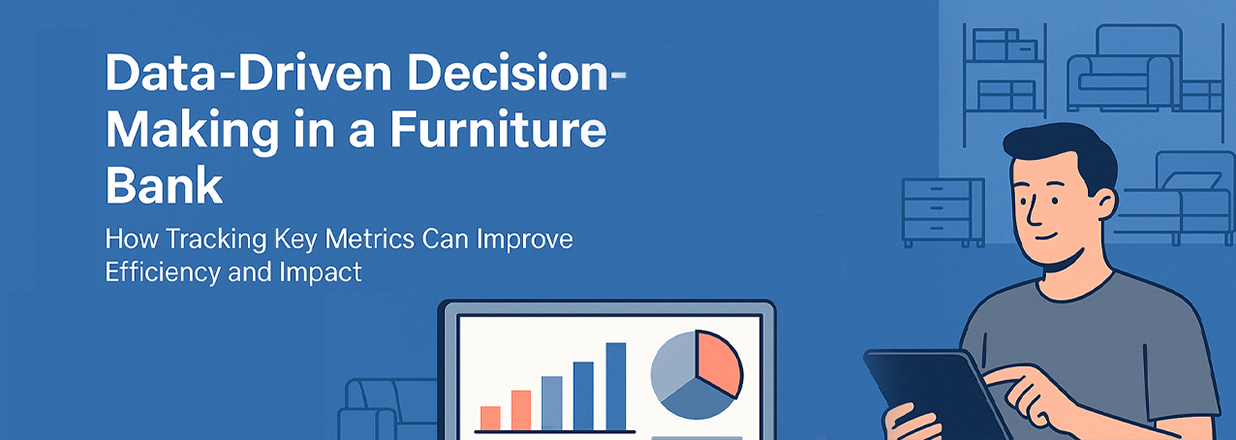
Data-Driven Decision-Making in a Furniture Bank
How Tracking Key Metrics Can Improve Efficiency and Impact
In the nonprofit world, especially in a mission-driven environment like a furniture bank, it’s easy to default to the urgent: today’s donation pickups, tomorrow’s deliveries, next week’s volunteer orientation. But behind every logistical puzzle is an opportunity to learn—and improve. That’s the power of data-driven decision-making.
When furniture banks begin tracking the right data, they start seeing more than just beds and sofas—they see patterns, opportunities, and untapped capacity.
Why Metrics Matter in a Furniture Bank
Furniture banks operate at the intersection of logistics, human services, and volunteerism. That complexity makes it all the more important to have visibility into your operations. Tracking key metrics allows you to:
- Understand your capacity
Are you serving as many clients as you could be? Do you have enough delivery slots, or are clients waiting too long? - Improve resource allocation
Are you overstocked on some items while constantly short on others? Do certain zip codes require more travel time and gas costs? - Identify trends and gaps
Is demand growing in certain regions? Are clients being referred faster than you can serve them? - Demonstrate impact
Can you show donors that their support helped furnish 500 homes this year with over $250,000 in value?
Real-World Benefits of Data-Driven Practices
Let’s take a few concrete examples:
A furniture bank noticed that many of its deliveries were being delayed due to inventory shortages—specifically, beds and dressers. By tracking this consistently, they launched a targeted bed drive and partnered with local mattress manufacturers. Within two months, delivery backlogs dropped by 40%.
Another organization found through data analysis that clients referred by certain partner agencies were more likely to miss appointments. Rather than assume disinterest, they investigated further and discovered language barriers and transportation issues. This insight led to the creation of multilingual appointment reminders and a pilot transportation stipend program.
Yet another tracked volunteer hours and realized that their warehouse volunteers were burning out during the busiest weeks of the month. By proactively adjusting the schedule and adding more support during peak periods, they increased both volunteer satisfaction and productivity.
These aren’t outliers—they’re examples of what happens when data becomes part of the culture.
Start Small, Think Big
You don’t need a fancy CRM or a data analyst to start. Begin by identifying key metrics aligning with your mission and operations. Examples might include:
- Households served per month
- Number of items distributed per household
- Average turnaround time from referral to delivery
- Percentage of deliveries completed on schedule
- Inventory stockouts for high-demand items
- Volunteer hours logged per week
Even tracking this in a simple spreadsheet can give you insight. The key is to be consistent and curious. Over time, patterns emerge that can guide decisions.
Making Data Actionable
Collecting numbers isn’t enough—you have to use them. Here’s how:
- Set Benchmarks: Once you know your average turnaround time is 10 days, you can set a goal to reduce it to 7.
- Schedule Reviews: Make data review a monthly staff habit, not an annual panic.
- Share Results: Include impact data in your board meetings, grant reports, and volunteer newsletters.
- Use Tools that Work for You: Data shouldn’t be a burden. Solutions like furniturebank.net offer purpose-built systems for tracking client data, inventory, and impact, so you don’t have to reinvent the wheel.
Build a Culture of Learning
When data becomes a regular part of your decision-making, it changes your culture. Staff and volunteers start asking better questions. Donors feel more confident in your effectiveness. And most importantly, clients benefit from a more responsive, efficient, and accountable organization.
Data-driven decision-making isn’t just a trend—it’s a strategy for sustainability and impact. And for furniture banks, it’s a powerful way to serve more families, more effectively, with the resources you already have.
Next Steps
Ready to begin your data journey? Start by identifying three questions you’d love to answer about your operation. Then look at what data you’re already collecting—and where there are gaps. And if you’re looking for an easier way to manage it all, furniturebank.net might be the right next move.

